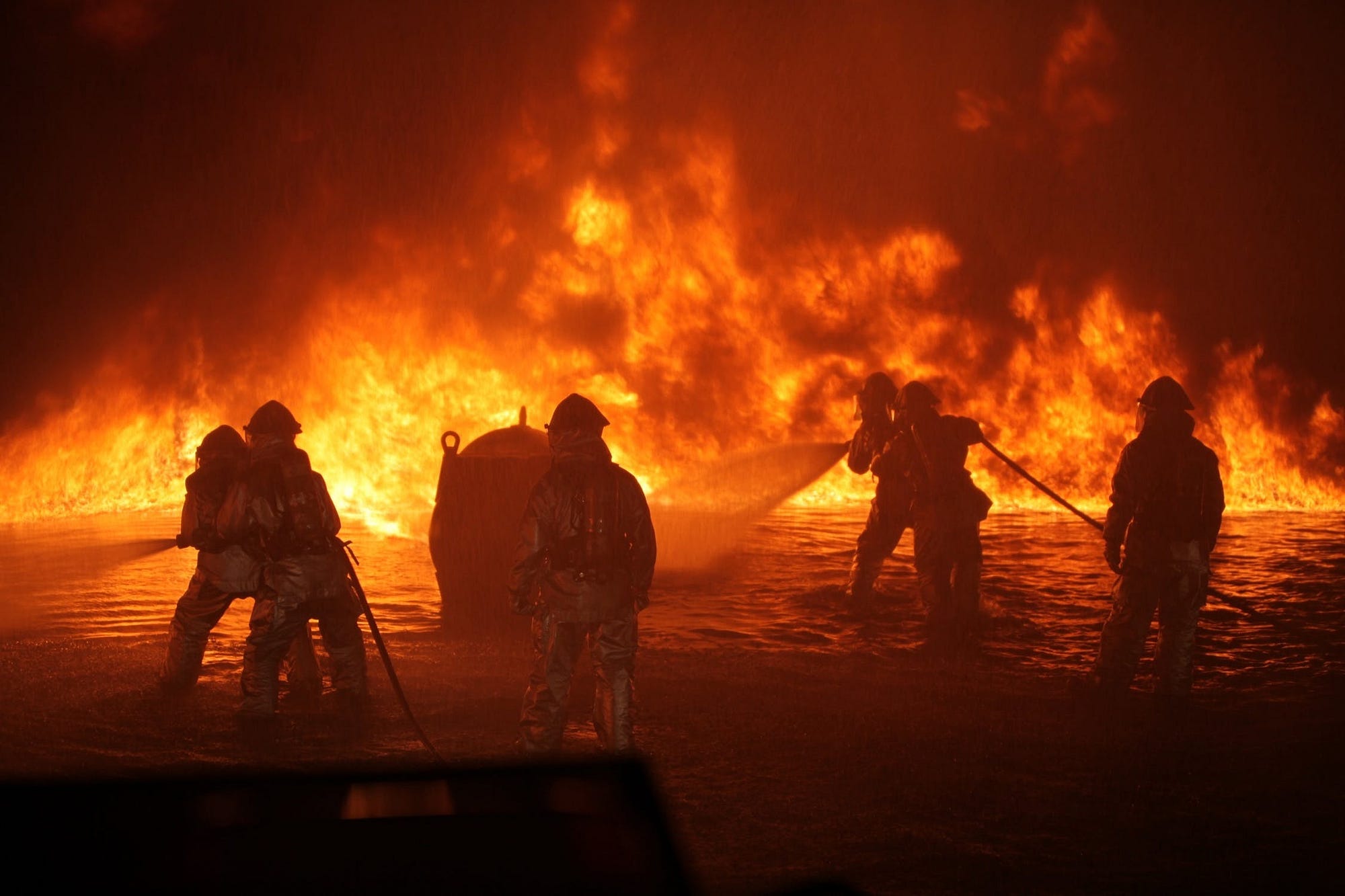Has Global Violence Declined A Look At The Data
Are we really living in the most peaceful time in human history? It all depends on how you measure: Reality Project Episode 2
In his sweeping 2011 work The Better Angels of Our Nature: Why Violence has Declined, Steven Pinker makes the audacious claim, “today we may be living in the most peaceable era in our species’ existence.” To someone who pays even a little attention to constant news reports of violence, both local and international, this statement sounds ludicrous. The grandeur of this assertion should immediately raise our suspicions; as the science popularizer Carl Sagan often said, “extraordinary claims require extraordinary evidence.” Does Pinker have that evidence and does he interpret it correctly?
Over the course of 800 pages, Pinker makes a convincing argument with numbers, figures, and references to many books and articles. Nonetheless, it’s critical that we don’t rely on a single argument to form our worldview. We must remember that data is never objective, and therefore we need to look at the data itself as well as multiple expert interpretations. In this article, we’ll examine the global violent conflict data and different stances on the same numbers. (As a note, Pinker’s work deals with all forms of violence from the individual — homicides, abuse — to the worldwide, but here we’ll focus on international violent conflicts — war — and leave the rest for future articles).
This is Episode 2 of the Reality Project, an endeavor with the aim of becoming less wrong about the world with data. You can find all the articles here.
(I’d like to emphasize I’m not trying to minimize the atrocities of war by presenting only data. It can be easy to lose track that we are talking about people when looking at numbers and every loss of human life is a tragedy.)
The Data
Our primary sources of derived data on the more positive side will be The Better Angels of Our Nature by Steven Pinker and the “War and Peace” page on Our World in Data. For a contrasting viewpoint, we’ll use “Steven Pinker is Wrong” by John Gray and “The Decline of Conflict: What Do the Data Really Say?” by Pasquale Cirillo and Nassim Nicholas Taleb. You can find raw data for your own analysis at The Conflict Catalog or the World Bank.
The first question we need to ask to assess violence today is how violent was the past. While extremely reliable data is difficult to come by, anthropologists use archaeological evidence to determine causes of death and therefore approximate the rates of violence in a society. These results are shown in the following graphs of percentages of deaths that come from violent conflict in prehistoric and non-state societies (from Our World in Data).
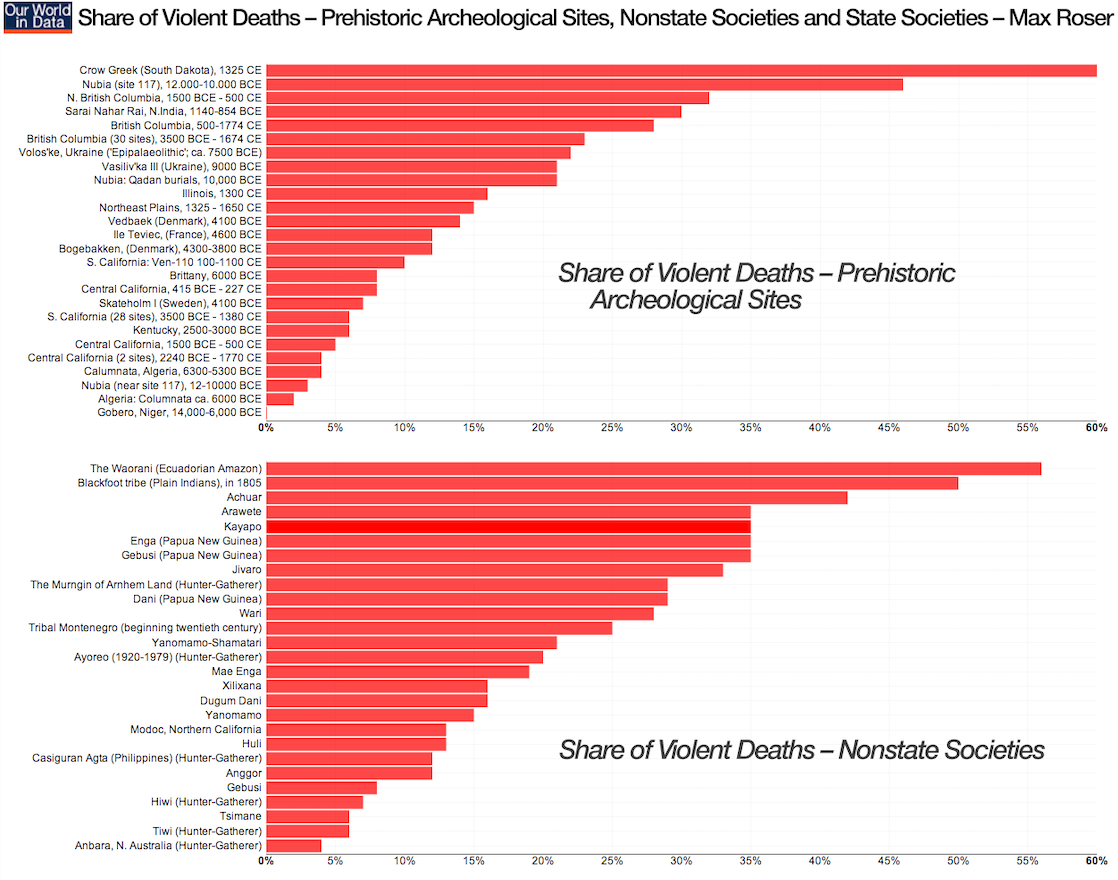 Percentage of deaths attributed to violence in prehistoric and nonstate societies
Percentage of deaths attributed to violence in prehistoric and nonstate societies
The percentages of individuals killed by violence ranges from about 60% to less than 5% in both prehistoric and nonstate societies. Those numbers are almost meaningless until we put them in perspective with modern figures:
 Percentage of deaths attributed to violence in state societies
Percentage of deaths attributed to violence in state societies
The most relevant entries are the final two. The US and Europe from 1900–1960, even with two world wars, saw less than 1% of their population perish in armed conflicts. In 2007, just 0.04% of deaths in the world were from international violence. If this data is correct, the world in 2007 was at least an order of magnitude safer than most prehistoric societies.
We can also look at the same data in a slightly different manner, as the violent deaths per 100,000 citizens per year.
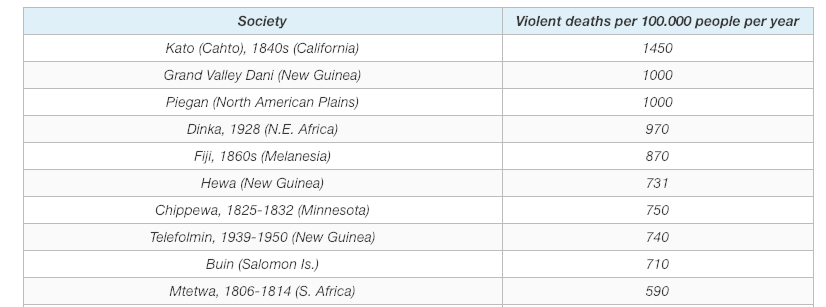
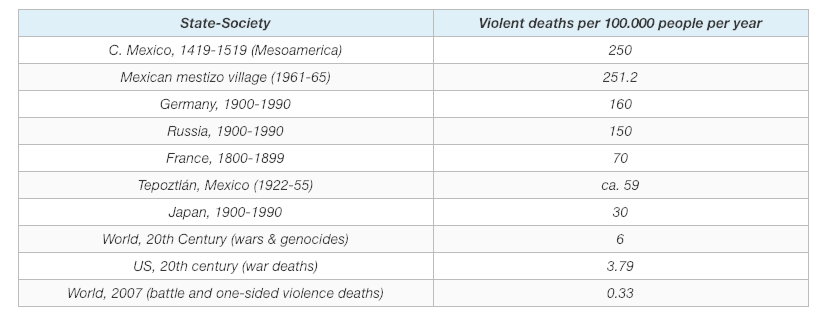 Left: violent deaths per 100,000 citizens per year in non-state societies. Right: same data for state societies.
Left: violent deaths per 100,000 citizens per year in non-state societies. Right: same data for state societies.
Here we again see the same pattern of lower violence in modern times. On the left are non-state societies and on the right are state societies. Focusing on the bottom 3 rows of the right-hand table, we can see the strikingly low rates of violent death among modern societies, even accounting for two world wars. Again, it’s worth stressing the data here is not complete, but what is available suggests the following hypothesis: prehistoric and nonstate societies experienced much higher rates of violence than modern state societies.
As Pinker and others (notably Jared Diamond) have made clear, the “noble savage” idea is entirely false. People did not live peacefully with one another when they were organized in tribes and then become more violent as they were civilized, but the opposite: they were extremely violent in tribes and gradually became less so as larger civilizations were built and commerce started to connect the world (this highlights two of the drivers in the decline of global war — trade and powerful states — that we’ll look at shortly). Even accounting for the atrocities wrought by nation-states in the 20th century, rates of violent death appear to be lower now than at any previous point.
It’s worth looking into the period of time for which we have the best data: the modern age. In particular, we’ll zoom in on the post-1945 era, a time that Pinker has classified as “The Long Peace”. From this vantage point, things look very good. As noted by Pinker, since 1953, there have been zero conflicts between major world powers (the exception since WW2 was the Korean War) and there have been zero internationally recognized states that have gone out of existence through conquest since 1945.
When we look at the data on battle deaths per 100,000 people in state-based conflicts, we see a significant decline since World War Two.
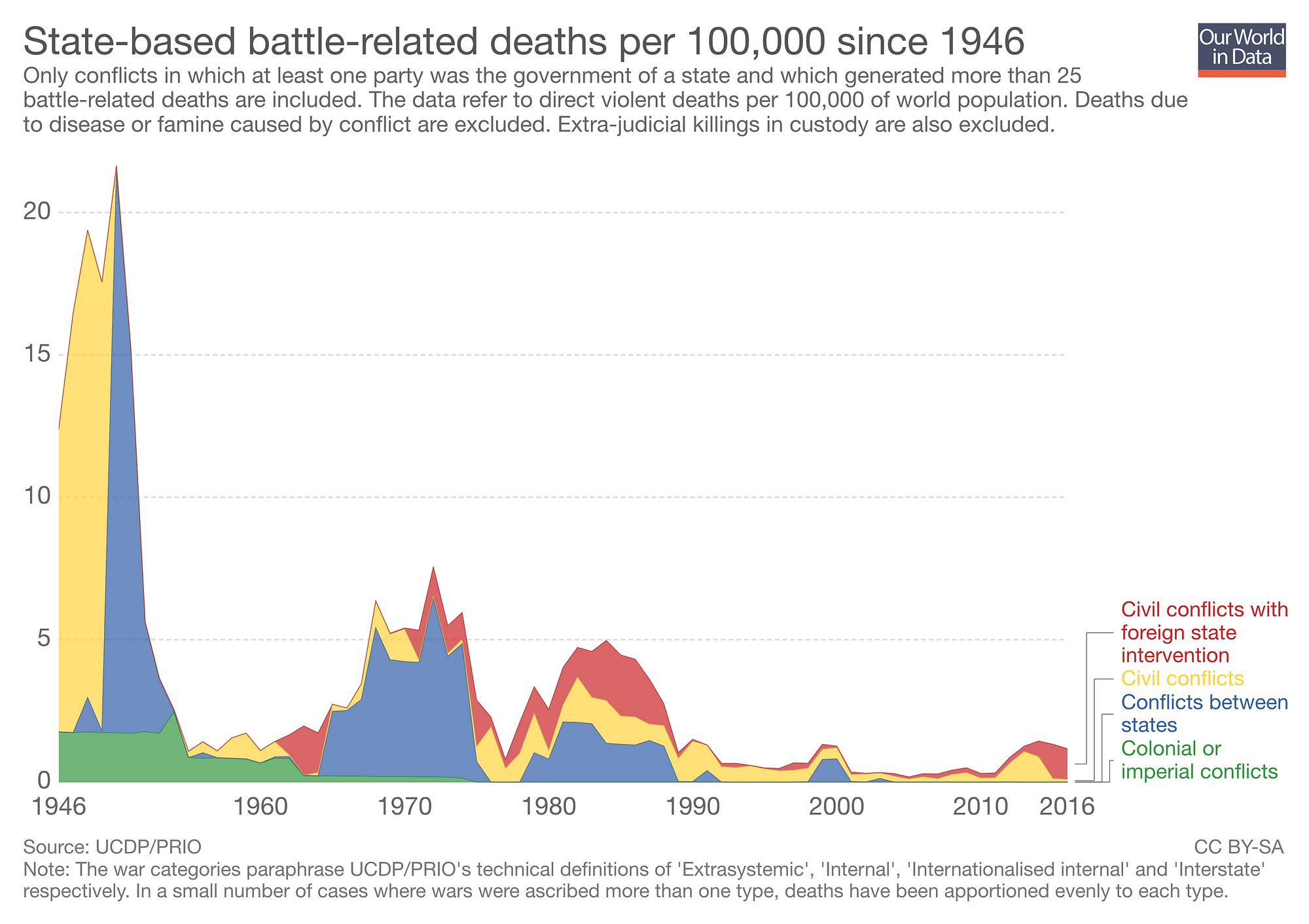 State-based violent conflict deaths from World War Two on
State-based violent conflict deaths from World War Two on
Since the end of the second world war, the rate of deaths from all conflicts has decreased, with the most noticeable decline in conflicts between states. Most of the remaining battle deaths occur in civil conflicts, such as the tragic civil war in Syria that has been ongoing since 2011. Moreover, many of these civil wars involve foreign states, and the argument could be made major states have stopped fighting each other directly, but engage through other conflicts.
One discouraging bit of news in contrast to the above graph is the number of overall state conflicts since the second world war:
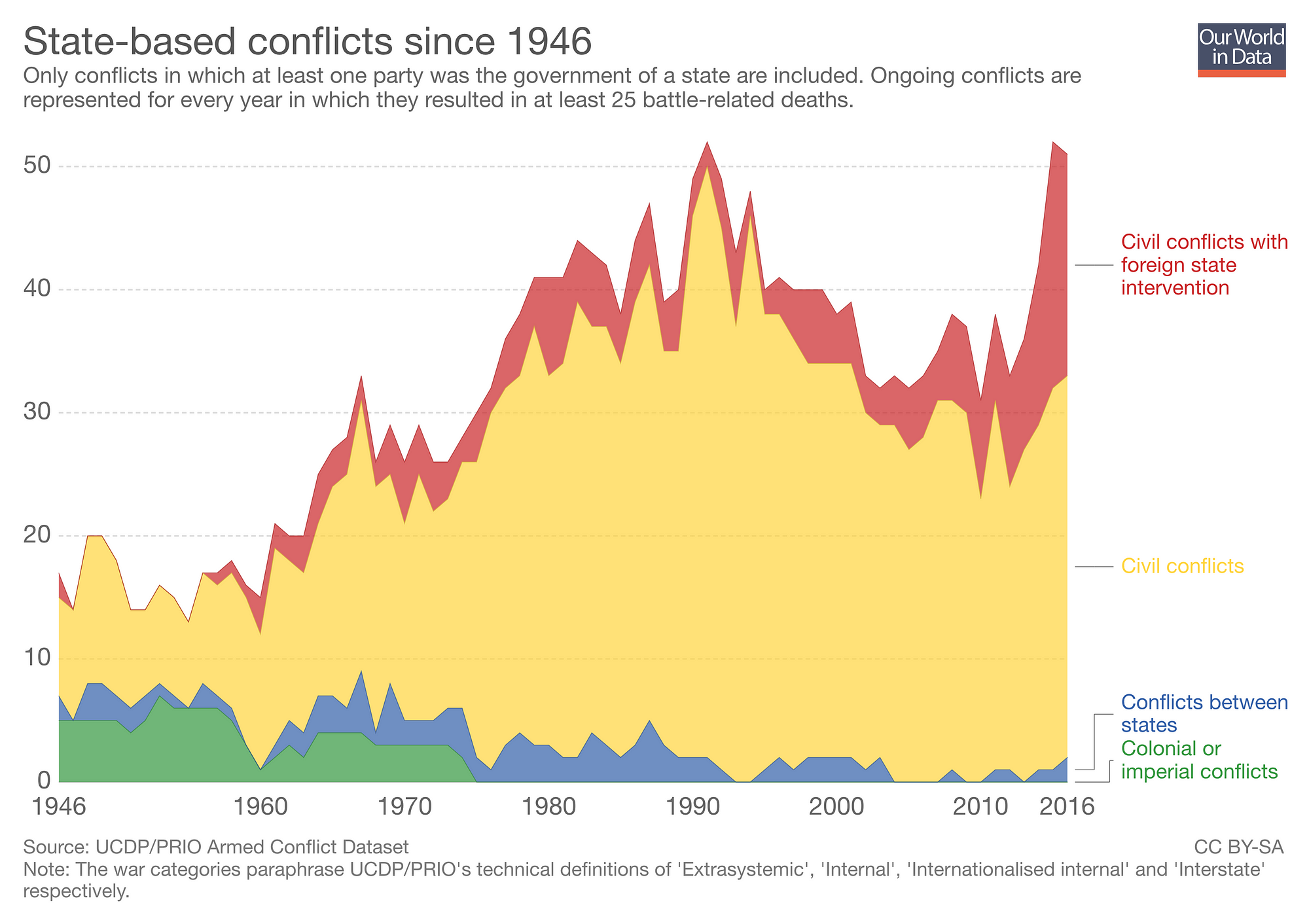 Number of state-based conflicts since the end of World War Two
Number of state-based conflicts since the end of World War Two
While the number of battle-related deaths (in the rate of people killed / 100,000 / year) has decreased, the total number of conflict is rising. This tells us that, contrary to what we might think as weapon technology advances, violent conflicts are resulting in fewer battle deaths. While, there are more civil conflicts around the globe, these tend to be less catastrophic than wars between major powers.
Fortunately, the wars between major states have been on the decline — even including the entire 20th century — and show no signs of reversal. We can see this in the final chart of section showing the percent of the time major powers have been at war over the past 500 years (grouped into 25-year periods).
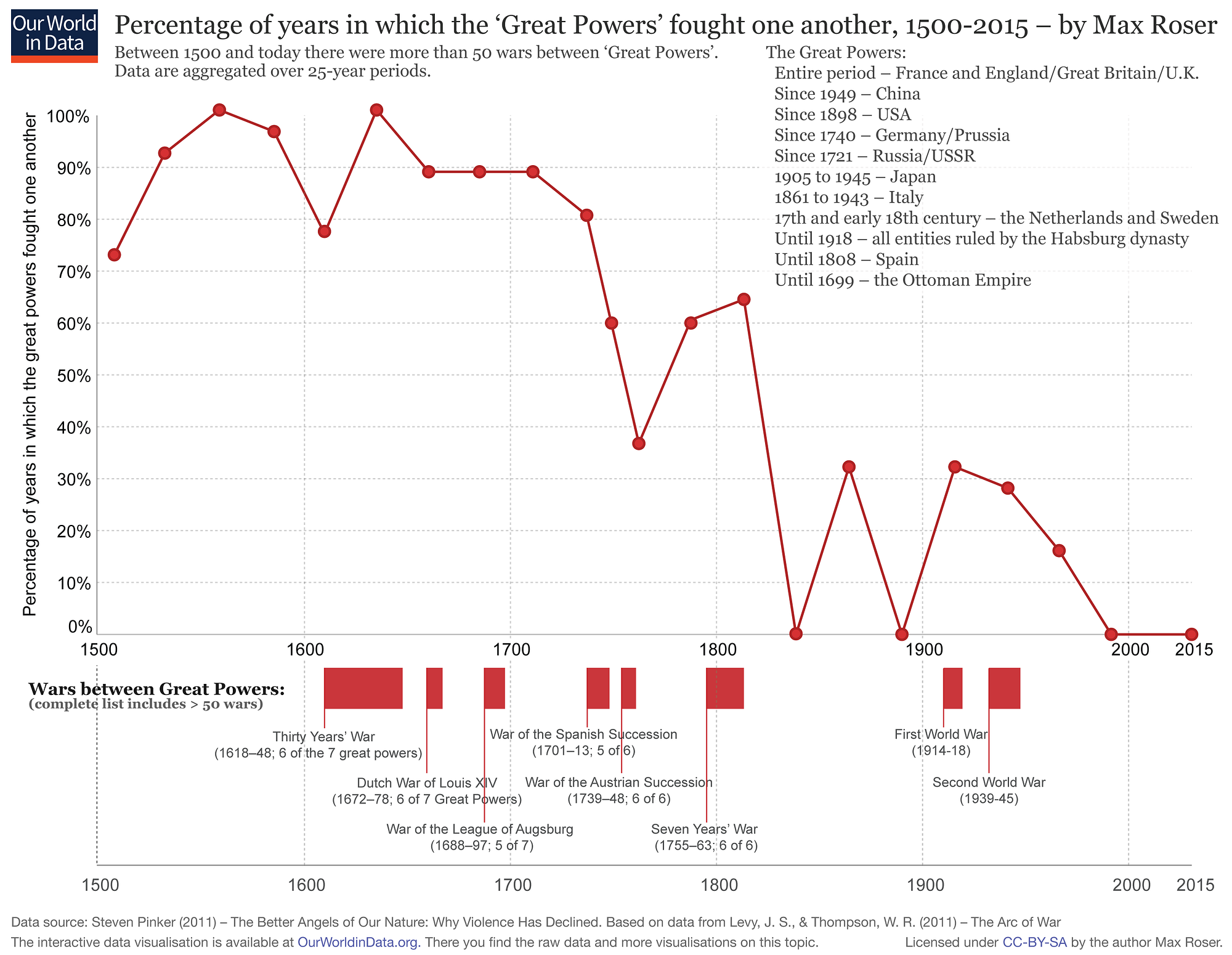 Percent of Years in which Great Powers Fought One Another (bunched into 25-year periods).
Percent of Years in which Great Powers Fought One Another (bunched into 25-year periods).
There has been a clear decline in the percentage of years in which the major powers fought with one another since at least 1600. At one point the rate reached 100% — indicating there was at least one conflict between world powers for the entire 25-year period. Contrast that with 2000, when there were 0 conflicts between world powers. The current period of 66 years without a conflict between major powers is the longest time since at least the Roman Empire.
After an exploration of the data thus far, Pinker’s argument looks to be holding up: the rate of death in battle for modern state societies in war is much lower than prehistoric and non-state societies even accounting for the world wars. Furthermore, the major powers no longer fight one another and while the number of civil conflicts has increased, these result in fewer deaths than conflicts between major states. However, before we consider this case to be closed we need to talk about one fundamental issue.
The Critical Question: Relative vs Absolute
Consider the following two scenarios:
- Two men are alone in a bar. After a brief disagreement, one pulls out a pistol and murders the other. The total is 1 dead for a rate of 50%.
- A minor civil war rages in a country of 1 million for several months. The total death count is 10,000 for a rate of 1%.
Which is worse? The question depends on your observation point. On the ground, observing from the location of the conflict itself, the bar is much worse. An individual in the bar has a 1 in 2 chance of being killed. From an outsider’s vantage point the civil war is much worse with a total loss of life 10 times greater. This is one of the central arguments that Pinker’s critics make: measuring violence in rates ignores the absolute numbers which means it does not account for the actual amount of human suffering.
One of Pinker’s harshest critics, Nassim Taleb, brings up the point of units in his response. He illustrates it with the following pair of plots:
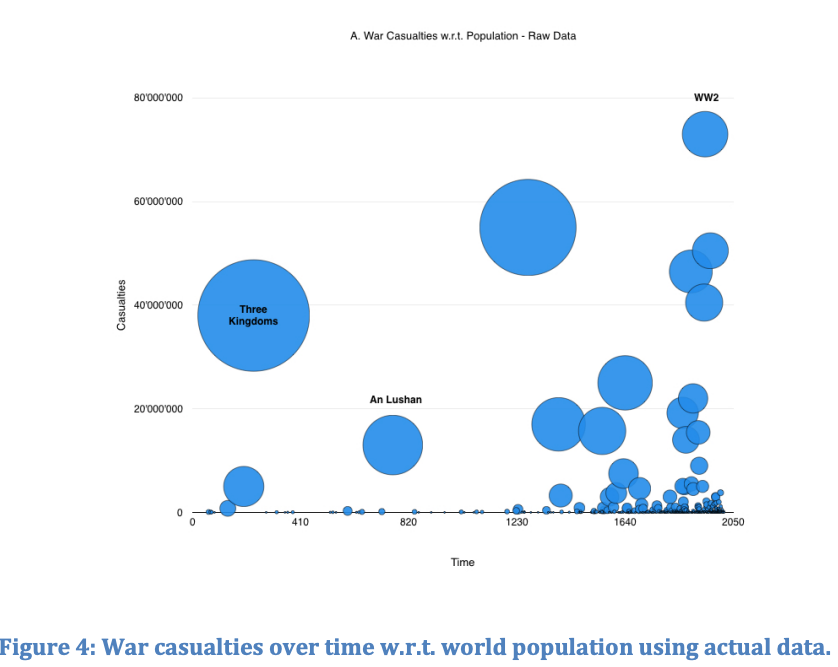
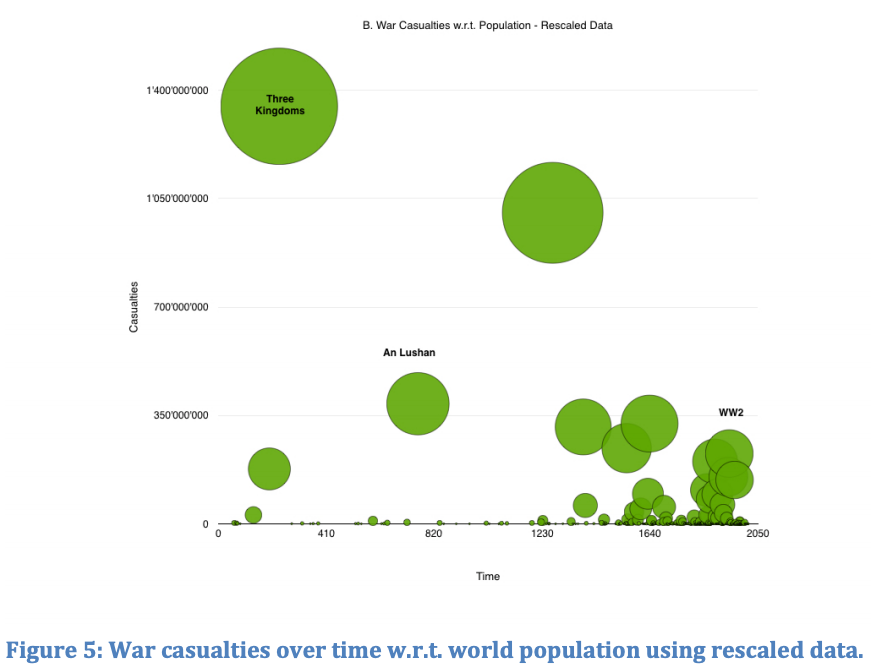 War casualties using raw data left and rescaled data right
War casualties using raw data left and rescaled data right
The graph on the left shows the raw number of casualties versus time for major conflicts. The graph on the right shows the rescaled version where the populations have been standardized across all times to have the same base population. As an example, if we have a population 100 society that suffers 2 deaths and a society with 1000 people that suffers 10, we would multiply 2 * 10 to get 20 deaths to account for the population difference.
These figures encapsulate the rates/absolute numbers argument: the rates of death in violent conflicts have clearly been decreasing and are at a historical low, but the actual number of deaths has increased over time. Although, it’s worth pointing out the actual number has decreased since 1950.
I don’t know if I have an answer for you on this problem of relative/absolute. As a utilitarian, I believe in bringing the greatest amount of total good to the greatest amount of people, and therefore, I see the total number of humans dead as the mark of how our civilization has failed. On the other side of the argument, a human alive today has less probability of being killed in a violent conflict than at any point in the past which is no doubt progress. I’ll let the facts stand and allow you to decide for yourself.
Even if we don’t want to make a judgment on the overall outcome, it’s worth taking a look at the potential causes for the reduction in rates of violence. In particular, we might want to think about why the total number of deaths (in addition to the relative measures) have fallen since 1945.
The Drivers of the Decline in Violence
For this section, we will look at Steven Pinker’s ideas as outlined in The Better Angels of Our Nature. (This work is the best look at potential reasons why violence has declined — partly because others refuse to concede this point). Pinker explains five forces, intended to account for the decline of violence on all scales, not just state-based conflicts, but we’ll focus on the first two which are most relevant to international conflict.
The five historical forces behind the reduction in violence are:
- Nation-states: the rise of societies ruled by a central government, in particular democracies, with a “monopoly on the legitimate use of force”
- Commerce: trade between nations allows us to engage in positive-sum interactions meaning our neighbors are worth more to us alive than dead
- Feminization: increased role of women in society and positions of power
- Rationality: Increased reliance on logical thinking instead of tradition for making policies and interacting with other humans
- Mass media and communication: made it possible for people to see outsiders not as dangerous, but as humans with a common humanity
Nation States, or the Leviathon
A powerful central government that can make and enforce laws using violence means that citizens are less likely to take punishment into their own hands, a concept known as the Leviathon theory. For all its romantic appeal, vigilante justice only leads to unending cycles of revenge violence. When citizens can count on a government to deliver fair punishments, they let the judicial system enforce the rules. Also, a state can prevent crime by making the penalty far greater than any potential payoff. Humans have the potential for both evil and good, and a strong central government with a fair criminal justice system with disincentives can steer them on the right path.
A strong government alone is not enough for keeping the peace between nations though. On an international scale, the evidence suggests that democracies don’t fight each other possibly because of the ideals they share in common. Looking at some of the data, it’s clear that democracies just don’t fight one another directly anymore (although they may engage in proxy war).
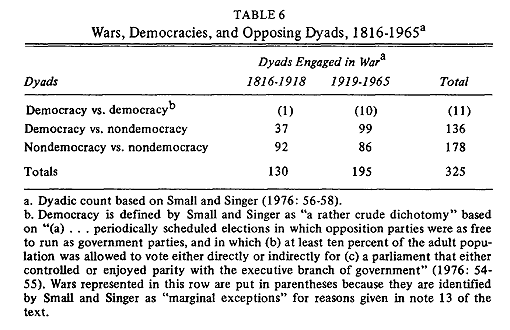 Conflicts between different forms of government (source)
Conflicts between different forms of government (source)
(For more on this concept see “Democratic Peace Theory.”)
The idea that one democratic nation will not fight another is good news as democracies on the rise in the long run worldwide as shown by Pinker:
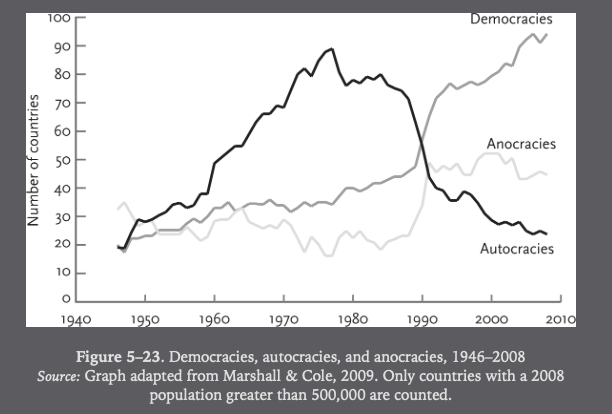 Types of government since the 1940s
Types of government since the 1940s
(One counterpoint is the recent decline in Democratic Index which measures not just the government but also freedom of the press and voting rights. Although the long-term trends are positive, the recent declines are worrying.)
Gentle Commerce
The theory of gentle commerce can be summed up in two statements:
- When it’s cheaper to buy something than to steal something, the economics wins
- Our neighbors — both within and outside our country — are worth more to us alive than dead because exchanges are positive-sum
Why don’t you steal a loaf of bread from the grocery store? Although most people believe they don’t steal because it’s the wrong thing to do, the real reason is more mundane: in our society, the potential cost of getting caught stealing — jail time and social ostracization — are higher than the cost to purchase items. When people are provided a legal means to obtain their goods that is cheaper than violence, they will take the legal option.
We explored the second point in “The Disappearing Poor”, but it’s worth reiterating. Without exchanges in a market economy, all interactions between humans are zero-sum: you can steal something from me, but your gain is offset by my loss so humanity is no better off; the size of the economy stays the same. However, in an exchange of goods, both parties come out better ahead.
Exchange also allows for specialization so different individuals/countries can make the goods for which they are best suited. Moreover, as trade continues, countries become dependent on one another because they no longer make all the goods they need. The end result of exchange is more plentiful goods at cheaper prices for all parties and improved international relations.
Over the past several hundred years, we have slowly built up an international marketplace where all players are heavily dependent on one another. The US will not fight with another major power, not because she couldn’t defeat them, but because the economic losses would far outweigh the gains. As discussed by Pinker, countries that depend more on each other for trade are less likely to have a violent conflict controlling for other factors. In summary, the financial incentives have switched from war to trade for most nations.
The Leviathon and gentle commerce actually work together — a strong government is able to create markets that allow for safe exchanges and enforce laws regulating trade. In other words, once you have a strong state, trading is easier, and more trading between nations means they are less likely to attack one another. As trade between world powers has increased, conflicts between major powers has also decreased to 0 since 1953.
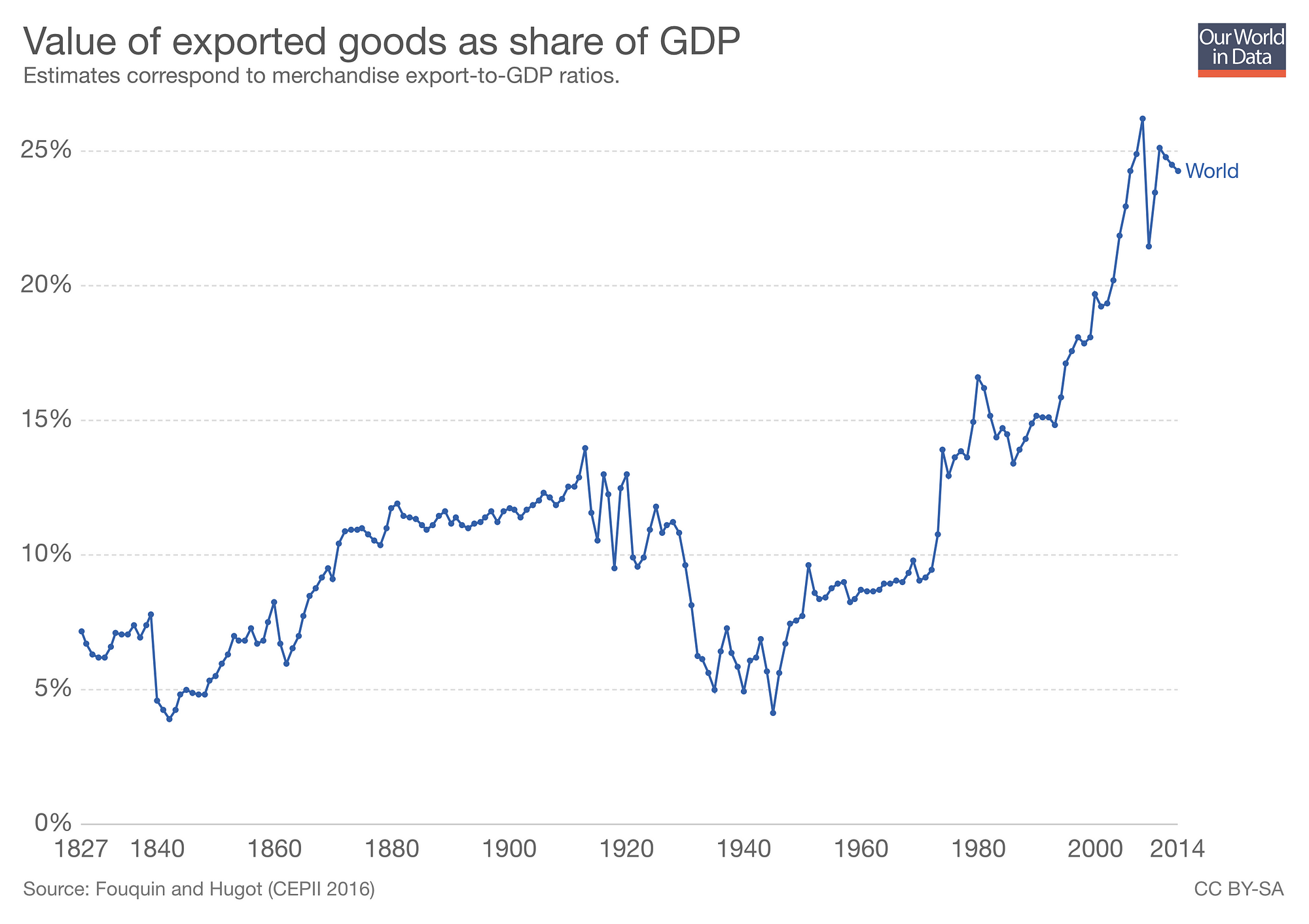 World trade as a percentage of GDP
World trade as a percentage of GDP
There are doubtless other factors that have played a role in the decline of war between nations. We discussed external historical factors behind the decrease, but Pinker and others (John Horgan in The End of War) have also outlined internal factors, like The Better Angels of Our Nature : empathy, self-control, morals, reason.
By examining the data and the reasons, it’s clear that the major powers no longer see war as a feasible choice. This is not necessarily because they are ethical, but because the economics of war no longer makes sense. At the end of the day, humans — and nations — are driven by incentives, and through international trade, we have built a world where the incentives favor peace.
Caveats and Conclusions
In a narrow point of view, Pinker is correct: rates of violent conflict have substantially decreased and there is reason to believe they are at the lowest point in human history (if only because data is limited). Also, at least among modern democracies, violence is no longer seen as the default option for solving problems as it has been for almost all of human history. That being said, it’s worth thinking about how Pinker’s argument made be misleading.
The first point is that by focusing on rates rather than numbers, we are neglecting the actual human suffering. More people dying from war is more people dying from war even if the percentage is decreasing. The numbers can be used to support multiple conclusions depending on one’s argument.
A second central issue is, especially for pre-historic societies, reliable data is hard to get. Most of the numbers for conflict rates and deaths in prehistoric societies come by examining archaeological sites and looking at artifacts for evidence of violent death. However, it could be possible these marks have been misinterpreted and anthropologists could not possibly have studied all prehistoric societies. Simple extrapolation what has been found is the only option, but it’s also important to not draw immature conclusions.
The last major issue we’ll cover here (for more see Taleb’s article) is that we could be living in an anomalous age. Pinker calls the most recent 70 years of peace (no wars between modern nations), “The Long Peace”, but it could be really only the temporary peace. Furthermore, as pointed out by Taleb, wars tend to be power law distributed, that is, they have long tails skewed to the right. The vast majority of deaths in armed conflicts are caused by a small number of the conflicts as can be seen below:
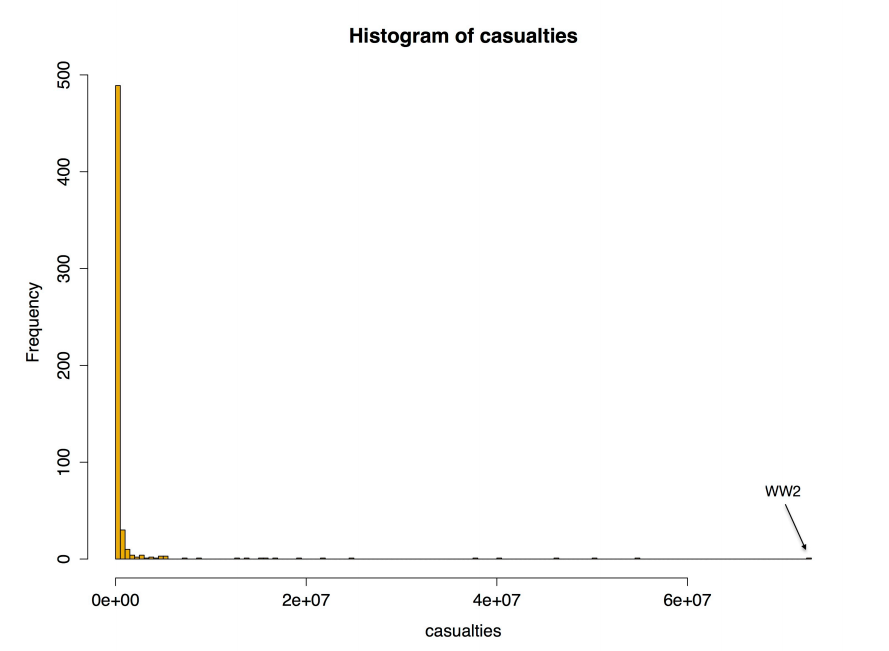 Distribution of war casualty deaths on log scale
Distribution of war casualty deaths on log scale
One single conflict can completely outweigh all others in terms of deaths. Most of the armed conflicts since 1945 have fallen on the low end of the scale, but it only takes a single major battle to overshadow the peace since 1945. It’s possible a new conflict, one caused by global warming, resource shortages, or territorial disputes, could entirely undo the millennia of progress humans have made on violence reduction efforts.
Initially, after reading Pinker’s book, I was convinced by his thesis. However, after taking the time to dig through the facts myself, a more nuanced picture emerged, one where sensationalist conflicts on both sides are not warranted. I see reasons for optimism: decreasing rates of deaths in armed conflicts mean a human alive today is less likely to die in battle than in recorded history, no battles between major powers since 1953, and a reduction in overall battle deaths since the 1950s, as well as reasons for pessimism: democracy and international trade, so important for reducing major conflicts, appear to be on a decline in recent years. Moreover, while major powers no longer fight directly with each other, they are involved through proxy wars.
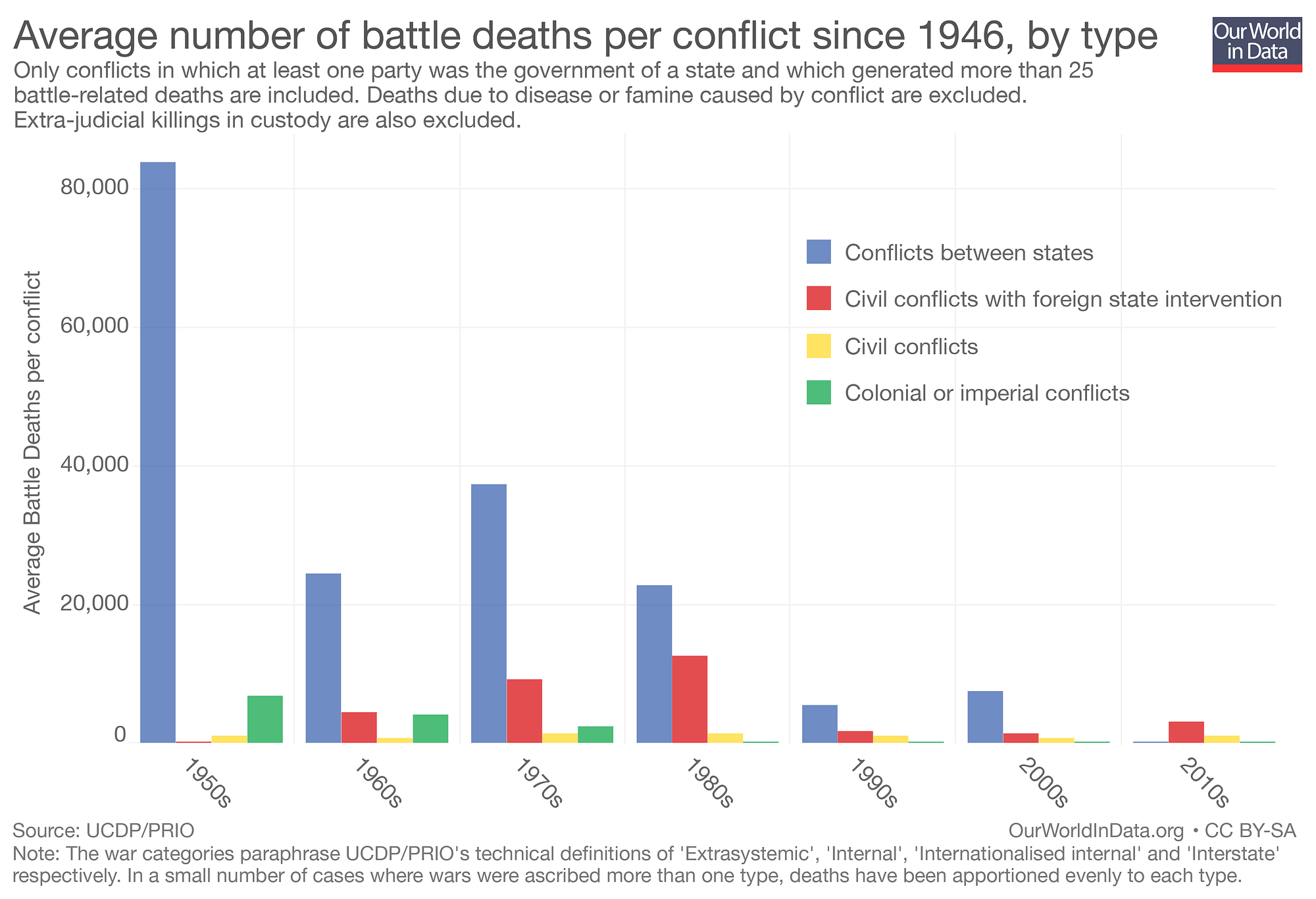 Things could be much worse, but they could also be better.
Things could be much worse, but they could also be better.
The exploration of violent conflict highlights the objective of the Reality Project. It’s not designed to be a feel-good effort but a fact-based endeavor, and, thus, any time I encounter an argument that is appealing to me this should only tell me to be more skeptical. The Reality Project has allegiances to no single interest, except getting at the actual statistics behind our world. It’s nice when the facts make us optimistic, but even when they don’t, it’s critical to understand the data so we can work to improve things.
As always, I welcome feedback and constructive criticism. I can be reached on Twitter @koehrsen_will.
